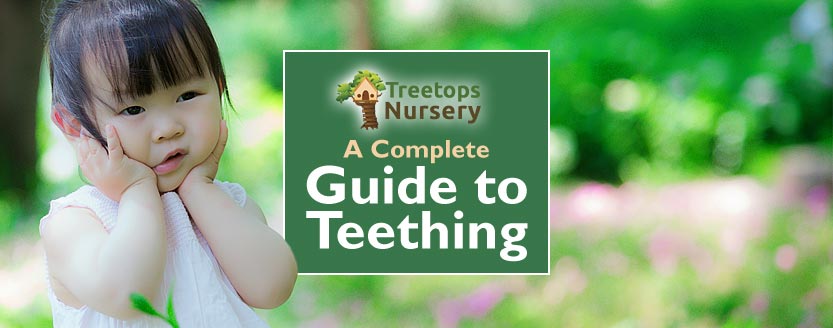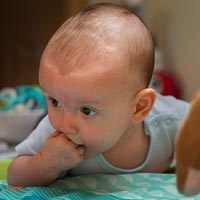
 In this, the first of two new posts relating to the very youngest of children, we’re looking at teething, including when it usually happens and what to do about it as a parent or carer. Teething can be stressful for parents and a painful time for babies, so it’s important to read the signs correctly and act accordingly.
In this, the first of two new posts relating to the very youngest of children, we’re looking at teething, including when it usually happens and what to do about it as a parent or carer. Teething can be stressful for parents and a painful time for babies, so it’s important to read the signs correctly and act accordingly.
Teeth in Humans
Let’s start at the beginning. Humans usually have two sets of teeth during their lives:
- First, children get their Milk Teeth at a very early age (more details follow below). These are also sometimes referred to as Baby Teeth, Primary Teeth or Deciduous Teeth. We’ll stick with Milk Teeth for the purpose of this article.
- Later, on average by the age of twelve, come the more permanent adult teeth. These are known as the Permanent Teeth or Secondary Teeth. We’ll refer to them simply as adult teeth in this article.
Fun fact: some reptiles grow thousands of new teeth in their lifetimes. Not so for humans, though!
Apart from their two sets of teeth, humans do not ‘grow’ further teeth as they are lost or fall out. This is common to most mammals.
Milk Teeth
 Most babies are born with no teeth showing at all. However, there are exceptions and it’s reasonably common to be born with one or more milk teeth already visible. In total, babies will have a total of 20 milk teeth; 10 in the upper jaw and 10 in the lower. These are already there at birth as they will have grown during the embryonic stage. However, they are hidden within the gums in most cases.
Most babies are born with no teeth showing at all. However, there are exceptions and it’s reasonably common to be born with one or more milk teeth already visible. In total, babies will have a total of 20 milk teeth; 10 in the upper jaw and 10 in the lower. These are already there at birth as they will have grown during the embryonic stage. However, they are hidden within the gums in most cases.
Teething
On average, babies’ teeth start to ‘erupt’ (protrude through the gums) at the age of about 6 months. The process of erupting is known as teething. The order of appearance of milk teeth usually goes something like this:
| Age c. 6-10 months | The lower central incisors appear |
| Age c. 8-12 months | The upper central incisors appear |
| Age c. 9-13 months | The top lateral incisors appear |
| Age c. 10-16 months | The bottom lateral incisors appear |
| Age c. 13-19 months | The 1st upper molars appear |
| Age c. 14-18 months | The 1st lower molars appear |
| Age c. 16-22 months | The upper canines appear |
| Age c. 17-23 months | The lower canines appear |
| Age c. 23-31 months | The lower 2nd molars appear |
| Age c. 25-33 months | The upper 2nd molars appear |
The milk teeth have usually all appeared through the gums by the age of 2½ to 3 although, as with everything, some cases may differ.
Teething lasts for about 8 days for each of the teeth erupting. Half of that is before the tooth appears and the other half is once it’s first appeared through the gum. In between, a bluey-grey colouration may be visible on the gum where the tooth is about to erupt. This is known as an ‘eruption cyst’ and is quite normal, usually disappearing on its own. As the largest of the teeth, molars tend to cause the most discomfort for babies/toddlers when coming through.
Symptoms of Teething
 Teething can cause babies pain and discomfort during the 8 days in which each tooth moves from under the gum to erupting through it. Apart from the obvious signs of the tooth erupting and perhaps a bluey-grey eruption cyst colouration in the gums, symptoms of teething include:
Teething can cause babies pain and discomfort during the 8 days in which each tooth moves from under the gum to erupting through it. Apart from the obvious signs of the tooth erupting and perhaps a bluey-grey eruption cyst colouration in the gums, symptoms of teething include:
- drooling (dribbling);
- sore-looking gums where teeth are moving to the surface;
- possible flushing of the cheeks;
- a tendency for the baby to chew things more than usual (including biting their own hands, toys etc.);
- the baby may also rub their ears;
- the baby might be more tearful than usual.
If you are at all concerned about the health and wellbeing of your child, consult a doctor or call the NHS on 111
How to Help Babies Through Teething
 There are a number of ways parents and carers can help babies and toddlers through their teething. One or more of the following may help:
There are a number of ways parents and carers can help babies and toddlers through their teething. One or more of the following may help:
- Teething rings are available commercially and little ones may find some comfort from chewing on them. At the very minimum, they will distract from any pain and discomfort. Some may suggest cooling the rings in the fridge (never the freezer) but it’s important to follow instructions and keep safety considerations to the fore at all times — for example never tie a teething ring around a child’s neck.
- Once they reach the age of 6 months or more, try giving them healthy fruit like apple or carrot pieces to chew on. The NHS also suggests breadsticks and crusts of bread but they should only chew any of these things under close adult supervision, to ensure that they are staying safe and not choking.
- Distraction can also be a useful tactic, so playing with your baby/toddler or comforting them will help.
- Using a clean finger, gently massaging their gums can also be of some comfort.
- Also ensure that you wipe your child’s face if they have been drooling. This will help to prevent rashes and soreness.
An Important Word About Teething Gels
 According to the NHS, there is no evidence that commercially-available teething gels (including homeopathic ones) are effective, so they recommend that non-medical options like those above should be tried first.
According to the NHS, there is no evidence that commercially-available teething gels (including homeopathic ones) are effective, so they recommend that non-medical options like those above should be tried first.
However, they say that should parents/carers decide to try teething gels anyway, they should ensure that they are specifically made for young children and are licensed for use in the UK. Teething gels should really be purchased through pharmacies (ideally not the Internet*), who may be able to give further advice. The NHS also states that, “General oral pain relief gels are not suitable for children”.
* The NHS states that:
“Some unlicensed homeopathic gels advertised on the internet have been linked to serious side effects.”
More information on the NHS warnings is available here.
Teeth Brushing & Registering with a Dentist
As soon as the first tooth has come through, parents or carers should begin to the process of regularly brushing and should also register the child with a local dentist. It is quite a big topic in itself, so we have written a separate guide all about brushing children’s teeth (here).
Shedding Milk Teeth
 When the time is right (usually by the age of 6) the milk teeth will start to shed. Normally, this is done in a particular order: first the two lower front teeth and the two upper front teeth will fall out (these are called the central incisors). Next to fall are the lateral incisors, then the first molars, the canines and finally the second molars.
When the time is right (usually by the age of 6) the milk teeth will start to shed. Normally, this is done in a particular order: first the two lower front teeth and the two upper front teeth will fall out (these are called the central incisors). Next to fall are the lateral incisors, then the first molars, the canines and finally the second molars.
By the age of twelve, most people will have shed all of their milk teeth although some people retain one or more right into adulthood (usually a molar if so). Adults have a total of 32 adult teeth, comprising 8 incisors, 4 canines, 8 premolars and 12 molars (4 of which are the Wisdom Teeth). Each of these has a particular shape and function, although we’ll not delve further in view this article is primarily about infant teeth. It’s worth noting, however, that adult teeth are less white than milk teeth as they have thicker enamel and the ‘dentin’ layer beneath it is yellow in colour.
We hope this guide to teething has been useful to you and look forward to following up with more articles and guides in the near future. Perhaps bookmark this article or our main blog page and feel free to share on social media (share buttons can be found below this article).
Searching for Nurseries in Willesden, Willesden Green, Kensal Green, Harlesden, or NW10?
If you are looking for nurseries in Willesden, or near Willesden Green, Kensal Green or Harlesden around the London NW10 area, we might be able to help. Treetops Nursery offers high quality childcare for babies, toddlers and under-fives in Doyle Gardens in Willesden, London NW10. We’ll be happy to discuss a nursery place for your baby or child while a few places are still available. Please choose a contact method below if this is of interest:

